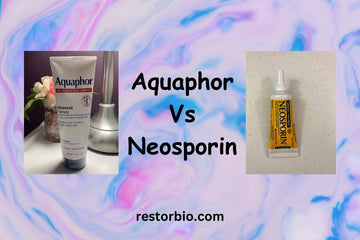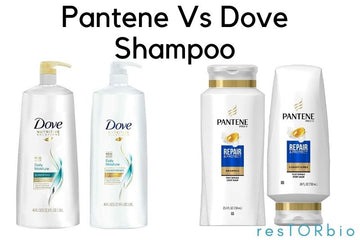
In the realm of skincare and wound care, there's a longstanding debate that has left many consumers scratching their heads: should they reach for Aquaphor or Neosporin when dealing with minor cuts, burns, and skin irritations?
As two of the most widely recognized and trusted brands in the market, both Aquaphor ointment and Neosporin ointment offer unique properties and benefits that can make it difficult to determine which one is best suited for specific situations.
But which one is truly the better option? In this Aquaphor Vs Neosporin, we'll dive deep into the world of these two products comparing their ingredients, benefits, and potential drawbacks, helping you make an informed decision for your skin's health and wellbeing. So, let’s find out about these two products.
Aquaphor Vs Neosporin: Overview
Aquaphor and Neosporin are two leading skincare products, each with its own set of advantages and uses, making them popular choices for treating minor skin irritations, cuts, and burns. In this overview, we briefly compare these two topical contenders to help you understand their key differences and make an informed decision for your skin's health.
About Aquaphor

Aquaphor, a renowned skincare brand known for its effective and versatile ointments, made its mark in the beauty and healthcare industry as the go-to solution for a plethora of skin concerns. With its unique formulation containing petrolatum, panthenol, and glycerin, Aquaphor's Healing Ointment works wonders in restoring smooth and healthy skin by providing a semi-occlusive barrier, attracting moisture, and promoting skin repair.
This multi-purpose product has gained immense popularity among consumers as it caters to various needs, such as treating dry, cracked skin, healing minor cuts and burns, providing relief from chapped lips, and even as a gentle and nourishing option for baby care.
The effectiveness of Aquaphor's products can be attributed to their commitment to high-quality ingredients and rigorous testing to ensure their products are gentle, safe, and suitable for all skin types. The brand's extensive range, including the classic Aquaphor Healing Ointment, Lip Repair, and Baby Healing Ointment, has garnered a loyal fan base among skincare enthusiasts and professionals alike. Dermatologists often recommend Aquaphor for addressing a wide array of skin issues, testifying to its reliability and efficacy in the skincare world.
In summary, Aquaphor's inventive approach to skincare and its diverse applications make it a staple in households across the globe, providing relief and comfort to those in search of healthier skin.
About Neosporin

Neosporin, a trusted name in first aid care, has been a household staple for decades due to its antibacterial and wound healing properties. This over-the-counter topical medication is a triple-action antibiotic ointment that contains a powerful combination of neomycin, polymyxin B, and bacitracin, which work synergistically to prevent infection and promote faster healing.
Neosporin is commonly used for treating minor cuts, scrapes, and burns, providing a protective barrier against harmful bacteria and reducing the risk of infection. The brand's commitment to offering safe and effective first aid solutions has made it a reliable choice for families and medical professionals alike.
Beyond its well-known antibiotic ointment, Neosporin has expanded its product range to cater to various first aid and skincare needs. Among these offerings are the Neosporin Pain Relief Cream, which combines the antibiotic properties of the original formula with an analgesic for added pain relief, and the Neosporin Eczema Essentials line, specially formulated to soothe and manage the symptoms of eczema-prone skin.
By continuously evolving and addressing a wide array of skin concerns, Neosporin has solidified its position as a leader in the first aid and skincare market. Its reputation for delivering effective, targeted solutions makes it a vital component of first aid kits around the world, ensuring that both minor and more severe skin issues can be managed with confidence and ease.
Aquaphor Vs Neosporin: Review
Aquaphor and Neosporin. Both brands have garnered loyal followings and are frequently recommended by medical professionals, but they cater to different needs and offer distinct benefits.
Aquaphor specializes in delivering gentle, moisturizing solutions for dry, cracked skin and protecting sensitive areas, while Neosporin focuses on preventing infection and promoting faster healing for minor cuts, scrapes, and burns with its antibiotic formula.
In this section, I will review both Aquaphor and Neosporin to help you make an informed decision on which brand best suits your specific skin care needs.
Aquaphor Review

As someone who has always dealt with sensitive and easily irritated skin, I've tried countless creams, lotions, and ointments in a desperate attempt to find some relief. That's when I discovered Aquaphor Healing Ointment, and I can honestly say that it has been nothing short of a game changer for my skin.
I remember the first time I applied Aquaphor to my parched skin after a long, tiring day. The ointment had a thick, petroleum jelly-like consistency that I was initially skeptical about. However, as I gently massaged it into my skin, I could feel the soothing effect almost instantly. The formula effortlessly glided over my dry, rough patches, and it wasn't long before the redness and irritation began to subside.
What really sets Aquaphor apart from other skin care products I've tried is its ability to provide a protective barrier that seals in moisture, allowing my skin to heal and recover. I've found that applying a thin layer of Aquaphor before bed helps to lock in the moisture overnight, and I wake up to soft, hydrated skin in the morning.
Another major plus for me is the versatility of this product. I've used Aquaphor on my lips, hands, feet, and even as a gentle eye makeup remover. It works wonders on my chapped lips during the colder months, and I've noticed that my cuticles are much healthier since I started massaging a small amount of Aquaphor into my nail beds each night.
While Aquaphor may not have the most appealing scent or luxurious packaging, its effectiveness in treating and preventing various skin issues far outweighs these minor drawbacks. I've even recommended it to friends and family who struggle with eczema, and they've all experienced significant improvements in their skin's condition after incorporating Aquaphor into their daily routines.
Neosporin Review

Neosporin has truly been a lifesaver for someone as accident-prone as me. Ever since I started using it, I have experienced a significant improvement in how quickly my cuts and scrapes heal.
What I appreciate most about Neosporin is its unique triple antibiotic formula. It not only speeds up the healing process but also ensures that my wounds remain infection-free. Plus, it has helped reduce the appearance of scars from past injuries.
The compact size of the Neosporin tube makes it incredibly convenient to carry around, whether in my purse, gym bag, or travel kit. I never have to worry about not having access to this trusted remedy when I need it.
While I haven't personally experienced any adverse reactions to Neosporin, I understand that some people might be allergic to certain ingredients. It's always a good idea to patch tests before applying it to a larger area.
In summary, Neosporin has become an indispensable part of my first aid kit. Its effectiveness in treating minor wounds and preventing infections has earned my trust and loyalty. Anyone in search of a reliable wound care solution should definitely give Neosporin a try.
Which is Better: Aquaphor or Neosporin?
I've always found myself debating whether to use Aquaphor or Neosporin for my wound care and skin healing needs. Personally, I appreciate how Aquaphor, a petroleum-based ointment, creates a moisture barrier that aids in the healing process and soothes my dry, cracked skin. On the other hand, I can't deny the effectiveness of Neosporin, a triple antibiotic ointment, in targeting and combating bacteria to prevent infection in minor cuts, scrapes, and burns.
However, I've encountered friends who've experienced allergic reactions to Neosporin's active ingredients, making Aquaphor a safer choice for those with sensitive skin. In the end, I believe that both products have their unique strengths—Aquaphor for moisturizing and Neosporin for infection prevention—so my decision ultimately comes down to the specific needs of my skin at any given time.
Comparison Between Aquaphor Vs Neosporin
In this brief comparison, I'll share my personal experience and insights into Aquaphor, a powerful moisturizer and emollient, and Neosporin, a potent antibiotic ointment. By understanding their unique characteristics, we can make more informed choices when selecting the right product for our individual skin needs.
| Feature | Aquaphor Healing Ointment | Neosporin |
| Main Purpose | Skin protection and moisturizing. | Antibacterial ointment for minor cuts, scrapes, and burns. |
| Active Ingredients | Petrolatum (41%) | Bacitracin, Neomycin, Polymyxin B |
| Other Ingredients | Mineral oil, ceresin, lanolin alcohol, panthenol, glycerin, bisabolol | , cottonseed oil, olive oil, sodium pyruvate, vitamin E, white petrolatum |
| Antibacterial Properties | No | Yes |
| Use on Open Wounds | Not recommended, as it does not contain antibacterial agents. | Recommended for minor cuts, scrapes, and burns to prevent infection. |
| Skin Types | All Skin types including sensitive skin | May not be suitable for individuals allergic to any of the antibiotics present in Neosporin. |
| Uses | Dry, chapped skin, diaper rash, minor burns, and skin irritations. | Wound care, infection prevention, and promoting wound healing. |
| Availability | Over-the-counter (OTC) | Over-the-counter (OTC) |
| Potential Side Effects | Rarely causes side effects; some individuals may experience skin irritation or an allergic reaction. | Possible allergic reactions, itching, rash, or swelling at the application site. |
| Price | Generally less expensive than Neosporin. | Slightly more expensive due to the inclusion of antibiotics. |
Aquaphor Vs Neosporin Active Ingredients

Aquaphor's primary active ingredient is petrolatum (41%), a highly effective moisturizing agent that forms a protective barrier on the skin, locking in moisture and aiding in skin healing. This makes Aquaphor an excellent choice for treating dry, chapped skin, minor burns, and skin irritations.

While Neosporin is an antibacterial ointment containing three active ingredients: bacitracin, neomycin, and polymyxin B. These antibiotics work together to combat a broad spectrum of bacteria, making Neosporin an ideal option for preventing infection and promoting wound healing in minor cuts, scrapes, and burns.
While both products offer unique benefits, the crucial distinction lies in their active ingredients, with Aquaphor primarily serving as a protective and moisturizing agent, whereas Neosporin focuses on infection prevention and wound care.
Aquaphor Vs Neosporin Skin Suitability

Aquaphor is a versatile skin care product that works well with virtually all skin types, including sensitive skin. Its gentle formulation, featuring petrolatum and moisturizing ingredients such as mineral oil, ceresin, lanolin alcohol, panthenol, glycerin, and bisabolol, helps to soothe and protect the skin without causing irritation. This makes Aquaphor an ideal choice for individuals with dry, chapped, or irritated skin seeking a gentle, hydrating solution.

Conversely, Neosporin, with its antibacterial properties derived from active ingredients bacitracin, neomycin, and polymyxin B, is primarily designed for wound care and infection prevention. While it may work for most skin types, individuals allergic to any of the antibiotics present in Neosporin should avoid using it, as it may cause allergic reactions such as itching, rash, or swelling at the application site.
In summary, Aquaphor is a gentle, versatile skin care product suitable for all skin types, while Neosporin is an antibacterial ointment designed for wound care and may not be suitable for those with antibiotic allergies.
Aquaphor Vs Neosporin Potential Side Effects

Aquaphor and Neosporin are both popular topical treatments for minor wounds and skin irritations, but they differ in composition and potential side effects. Aquaphor, a petrolatum-based ointment, serves as a skin protectant and moisturizer, primarily easing dry, cracked skin without any active medicinal ingredients. Consequently, Aquaphor has relatively fewer side effects, mainly limited to mild skin reactions like itching, redness or rash in rare cases.

In contrast, Neosporin, a triple-antibiotic ointment containing bacitracin, neomycin, and polymyxin B, targets and prevents bacterial infections in minor cuts, scrapes, and burns.However, this added benefit comes with an increased risk of side effects, including allergic reactions, itching, swelling, and redness. Furthermore, prolonged or excessive use of Neosporin may contribute to antibiotic resistance and, in rare cases, result in a severe allergic reaction called anaphylaxis.
In conclusion, while both Aquaphor and Neosporin offer valuable aid in treating minor skin concerns, their distinct compositions and potential side effects should be carefully considered when deciding which product best suits the needs of each individual.
Conclusion: Aquaphor Vs Neosporin
In conclusion, Aquaphor and Neosporin are distinct in their formulations, purposes, and suitability for different skin types and conditions. Aquaphor, with its petroleum-based composition, is primarily a protective and moisturizing agent that caters to a wide range of skin types, including sensitive skin. It excels at soothing and healing dry, chapped, and irritated skin with minimal potential side effects.
Conversely, Neosporin is an antibacterial ointment formulated with bacitracin, neomycin, and polymyxin B, targeting the prevention of infections in minor cuts, scrapes, and burns. Although it is effective for most skin types, individuals with antibiotic allergies should exercise caution when using Neosporin, as it carries a higher risk of side effects and potential allergic reactions.
Ultimately, the choice between Aquaphor and Neosporin boils down to the specific skin concerns and individual needs of each person. Aquaphor is an ideal choice for those seeking a gentle, protective, and moisturizing solution, whereas Neosporin is better suited for treating and preventing infections in minor wounds.
By understanding the unique properties and potential side effects of each product, consumers can make informed decisions and select the most appropriate treatment for their specific skin care needs.
Read More:




